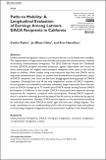Files in this item
Paths to mobility : a longitudinal evaluation of earnings among Latino/a DACA recipients in California
Item metadata
| dc.contributor.author | Patler, Caitlin | |
| dc.contributor.author | Hale, Jo Mhairi | |
| dc.contributor.author | Hamilton, Erin R. | |
| dc.date.accessioned | 2021-07-28T16:30:01Z | |
| dc.date.available | 2021-07-28T16:30:01Z | |
| dc.date.issued | 2021-08-01 | |
| dc.identifier | 271051660 | |
| dc.identifier | 505b3f46-2384-4f0b-b6e2-3ab307507e63 | |
| dc.identifier | 85102140222 | |
| dc.identifier | 000630798700001 | |
| dc.identifier.citation | Patler , C , Hale , J M & Hamilton , E R 2021 , ' Paths to mobility : a longitudinal evaluation of earnings among Latino/a DACA recipients in California ' , American Behavioral Scientist , vol. 65 , no. 9 , pp. 1146-1164 . https://doi.org/10.1177/0002764221996746 | en |
| dc.identifier.issn | 0002-7642 | |
| dc.identifier.other | ORCID: /0000-0003-1343-3879/work/90568129 | |
| dc.identifier.uri | https://hdl.handle.net/10023/23666 | |
| dc.description.abstract | Undocumented immigration status is a structural barrier to socioeconomic mobility. The regularization of legal status may therefore promote the socioeconomic mobility of formerly undocumented immigrants. The 2012 Deferred Action for Childhood Arrivals (DACA) program provided protection against deportation and access to work authorization for eligible undocumented immigrants who came to the United States as children. While studies using cross-sectional data find that DACA led to improved socioeconomic status, no studies have examined the socioeconomic status of DACA recipients over time and few have disaggregated among groups of DACA recipients. Drawing from one of the only longitudinal studies of DACA recipients, we use growth curve models to estimate individuals’ wage trajectories from the year prior to DACA receipt up to 77 months post-DACA receipt among Latino/a DACA participants in California. In this sample, DACA is associated with improved earnings trajectories for recipients, compared with nonrecipients. Among DACA recipients, there is variation in earnings growth by stage of the life course, as measured by age and educational attainment. Notably, DACA tenure appears to be particularly beneficial for individuals who attain DACA at earlier ages and who earn college degrees. This study contributes to our understanding of the role of immigration laws and policies in structuring immigrant integration and socioeconomic mobility in the United States. | |
| dc.format.extent | 19 | |
| dc.format.extent | 6609818 | |
| dc.language.iso | eng | |
| dc.relation.ispartof | American Behavioral Scientist | en |
| dc.subject | Undocumented immigrants | en |
| dc.subject | DACA | en |
| dc.subject | Immigrant integration | en |
| dc.subject | Economic integration | en |
| dc.subject | 1.5 generation immigrants | en |
| dc.subject | Latinos | en |
| dc.subject | G Geography (General) | en |
| dc.subject | Sociology and Political Science | en |
| dc.subject | Demography | en |
| dc.subject | 3rd-DAS | en |
| dc.subject | SDG 10 - Reduced Inequalities | en |
| dc.subject | SDG 8 - Decent Work and Economic Growth | en |
| dc.subject.lcc | G1 | en |
| dc.title | Paths to mobility : a longitudinal evaluation of earnings among Latino/a DACA recipients in California | en |
| dc.type | Journal article | en |
| dc.contributor.institution | University of St Andrews. Population and Health Research | en |
| dc.contributor.institution | University of St Andrews. School of Geography & Sustainable Development | en |
| dc.identifier.doi | 10.1177/0002764221996746 | |
| dc.description.status | Peer reviewed | en |
This item appears in the following Collection(s)
Items in the St Andrews Research Repository are protected by copyright, with all rights reserved, unless otherwise indicated.

